
Brackish water, sometimes termed brack water, is water occurring in a natural environment that has more salinity than freshwater, but not as much as seawater. It may result from mixing seawater and fresh water together, as in estuaries, or it may occur in brackish fossil aquifers. The word comes from the Middle Dutch root brak. Certain human activities can produce brackish water, in particular civil engineering projects such as dikes and the flooding of coastal marshland to produce brackish water pools for freshwater prawn farming. Brackish water is also the primary waste product of the salinity gradient power process. Because brackish water is hostile to the growth of most terrestrial plant species, without appropriate management it can be damaging to the environment.

Fish migration is mass relocation by fish from one area or body of water to another. Many types of fish migrate on a regular basis, on time scales ranging from daily to annually or longer, and over distances ranging from a few metres to thousands of kilometres. Such migrations are usually done for better feeding or to reproduce, but in other cases the reasons are unclear.

Pink salmon or humpback salmon is a species of euryhaline ray-finned fish in the family Salmonidae. It is the type species of the genus Oncorhynchus, and is the smallest and most abundant of the seven officially recognized species of salmon. The species' scientific name is based on the Russian common name for this species gorbúša (горбуша), which literally means humpie.
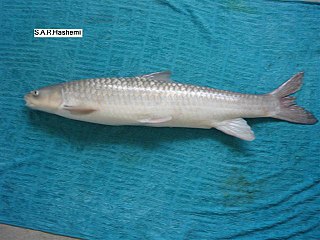
The shabout is a species of cyprinid fish also called in English, Persian or Arabic by the alternate common names shirbot and variations shabut, shabboot or shabbout, and in local languages by several other common names. It is a large freshwater carp found in Western Asia, where it inhabits the Tigris–Euphrates Basin, as well as Iranian rivers that flow into the Persian Gulf.

Tariqilabeo is a genus of fish in the family Cyprinidae native to Asia.

Freshwater fish are fish species that spend some or all of their lives in bodies of fresh water such as rivers, lakes and inland wetlands, where the salinity is less than 1.05%. These environments differ from marine habitats in many ways, especially the difference in levels of osmolarity. To survive in fresh water, fish need a range of physiological adaptations.

Unionida is a monophyletic order of freshwater mussels, aquatic bivalve molluscs. The order includes most of the larger freshwater mussels, including the freshwater pearl mussels. The most common families are the Unionidae and the Margaritiferidae. All have in common a larval stage that is temporarily parasitic on fish, nacreous shells, high in organic matter, that may crack upon drying out, and siphons too short to permit the animal to live deeply buried in sediment.
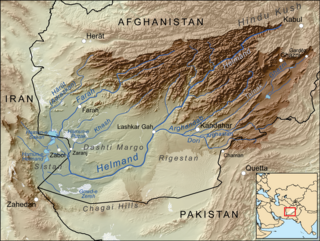
The Sistan Basin is an inland endorheic basin encompassing large parts of southwestern Afghanistan and minor parts of southeastern Iran. It is one of the driest regions in the world and an area subject to prolonged droughts. Its watershed is a system of rivers flowing from the highlands of Afghanistan into freshwater lakes and marshes and then to its ultimate destination: Afghanistan's saline Godzareh Depression, part of the extensive Sistan terminal basin. The Helmand River drains the basin's largest watershed, fed mainly by snowmelt from the mountains of Hindu Kush, but other rivers contribute also.
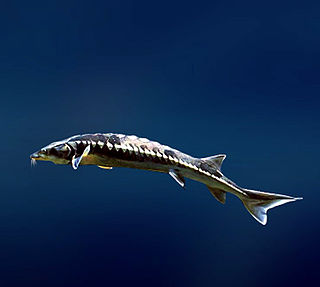
The bastard sturgeon, also known as the fringebarbel sturgeon, ship sturgeon, spiny sturgeon, or thorn sturgeon, is a species of fish in the family Acipenseridae. These fish are typically found along the benthos of shallower waters near shorelines or estuaries.
Freshwater bivalves are molluscs of the order Bivalvia that inhabit freshwater ecosystems. They are one of the two main groups of freshwater molluscs, along with freshwater snails.
Stenodus nelma, known alternatively as the nelma, sheefish, siifish, inconnu or connie, is a commercial species of freshwater whitefish in the family Salmonidae. It is widespread in the Arctic rivers from the Kola Peninsula eastward across Siberia to the Anadyr River and also in the North American basins of the Yukon River and Mackenzie River.
Tariqilabeo macmahoni is a species of freshwater ray-finned fish belonging to the family Cyprinidae, the family which also includes the carps, barbs, minnows and related fishes. This fish is endemic to Pakistan.
Schizothorax zarudnyi is a species of cyprinid freshwater fish from Iran and Afghanistan, where restricted to lakes in the Sistan Basin.
Tariqilabeo burmanicus, the Burmese latia, is a tropical freshwater species of fish in the family Cyprinidae, that is closely related to minnows and carps. It lives in the streams and rivers of mountains that are located in the Indian subcontinent, specifically India (Manipur) and Myanmar.
Acanthobrama persidis is a species of freshwater cyprinid fish, which is endemic to Maharlu Lake, the Kor River, and the Hormuz and Persis basins, Iran.
Acanthobrama urmianus is a species of freshwater cyprinid fish, which is endemic to the Urmia Lake basin of Iran.
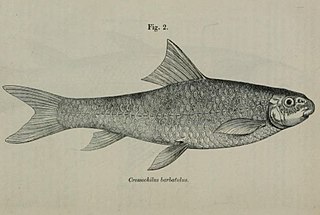
Tariqilabeo diplochilus is a species of ray-finned fish in the genus Tariqilabeo. It is found in the Indus drainage in Pakistan, Afghanistan and India, extending into the Iranian Sistān, and coastal drainages in Pakistan.

Gyraulus convexiusculus is a species of freshwater snail, an aquatic pulmonate gastropod mollusk in the family Planorbidae, the ram's horn snails.
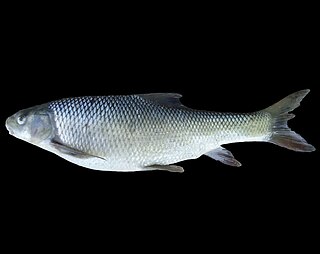
Capoeta kaput is a species of algae eating scrapers discovered in 2019. Known locally as the Blue Aras scraper, this rare species prefers large rivers. It has not been evaluated by the IUCN yet but may need protection. The freshwater fish primarily inhabits rivers of the Araxes basin in Asia, and has been found so far in at least Armenia, Iran and Turkey. C. kaput can be distinguished by several physical markers, such as its nine dorsal branched rays, a larger number of vertebrae than most other species in the genus, and it is about 262 mm (10.3 in) in length. The species has been discovered recently enough that it's been the subject of relatively little research.
Tariqilabeo wattanah, the Deccan latia, is a species of freshwater ray-finned fish belonging to the family Cyprinidae, the family which also includes the carps, barbs, minnows and related fishes. This fish is endemic to India, where it occurs in the Bhima and Godavari Rivers.











